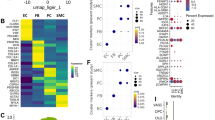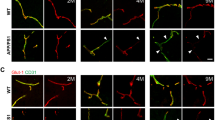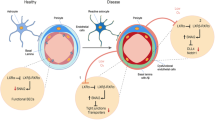Abstract
Neurovascular dysfunction substantially contributes to Alzheimer disease. Here, we show that transcriptional profiling of human brain endothelial cells (BECs) defines a subset of genes whose expression is age-independent but is considerably altered in Alzheimer disease, including the homeobox gene MEOX2 (also known as GAX), a regulator of vascular differentiation, whose expression is low in Alzheimer disease. By using viral-mediated MEOX2 gene silencing and transfer, we show that restoring expression of the protein it encodes, GAX, in BECs from individuals with Alzheimer disease stimulates angiogenesis, transcriptionally suppresses AFX1 forkhead transcription factor–mediated apoptosis and increases the levels of a major amyloid-β peptide (Aβ) clearance receptor, the low-density lipoprotein receptor–related protein 1 (LRP), at the blood-brain barrier. In mice, deletion of Meox2 (also known as Gax) results in reductions in brain capillary density and resting cerebral blood flow, loss of the angiogenic response to hypoxia in the brain and an impaired Aβ efflux from brain caused by reduced LRP levels. The link of MEOX2 to neurovascular dysfunction in Alzheimer disease provides new mechanistic and therapeutic insights into this illness.
This is a preview of subscription content, access via your institution
Access options
Subscribe to this journal
Receive 12 print issues and online access
$209.00 per year
only $17.42 per issue
Buy this article
- Purchase on SpringerLink
- Instant access to full article PDF
Prices may be subject to local taxes which are calculated during checkout





Similar content being viewed by others
References
Alzheimer, A. Uber eine eigenartig Erkrankung der Hirnrinde. Allg. Z. Psychiatrie Psych. Ger. Med 64, 146–148 (1907).
Zlokovic, B.V. Neurovascular mechanisms of Alzheimer's neurodegeneration. Trends Neurosci. 28, 202–208 (2005).
de la Torre, J.C. Alzheimer's disease is a vasocognopathy: a new term to describe its nature. Neurol. Res. 26, 517–524 (2004).
Gorelick, P.B. Risk factors for vascular dementia and Alzheimer's disease. Stroke 35, 2620–2622 (2004).
Casserly, I. & Topol, E. Convergence of atherosclerosis and Alzheimer's disease: inflammation, cholesterol, and misfolded proteins. Lancet 363, 1139–1146 (2004).
Roher, A.E. et al. Atherosclerosis of cerebral arteries in Alzheimer's disease. Stroke 35, 2623–2627 (2004).
Greenberg, S.M. et al. Amyloid angiopathy-related vascular cognitive impairment. Stroke 35, 2616–2619 (2004).
Bailey, T.L. et al. The nature and effects of cortical microvascular pathology in aging and Alzheimer's disease. Neurol. Res. 26, 573–578 (2004).
Farkas, E. & Luiten, P.G. Cerebral microvascular pathology in aging and Alzheimer's disease. Prog. Neurobiol. 64, 575–611 (2001).
Paris, D. et al. Impaired angiogenesis in a transgenic mouse model of cerebral amyloidosis. Neurosci. Lett. 366, 80–85 (2004).
Paris, D. et al. Inhibition of angiogenesis by Aβ peptides. Angiogenesis 7, 75–78 (2004).
Carmeliet, P. & Jain, R.K. Angiogenesis in cancer and other diseases. Nat. Med. 9, 653–660 (2003).
Shibata, M. et al. Clearance of Alzheimer's amyloid-β 1–40 peptide from brain by LDL receptor related protein-1 at the blood-brain barrier. J. Clin. Invest. 106, 1489–1499 (2000).
Deane, R. et al. LRP/amyloid β-peptide interaction mediates differential brain efflux of Aβ isoforms. Neuron 43, 333–344 (2004).
Tanzi, R.E. et al. Clearance of Alzheimer's Aβ peptides: the many roads to perdition. Neuron 43, 605–608 (2004).
Iadecola, C. Neurovascular regulation in the normal brain and in Alzheimer's disease. Nat. Rev. Neurosci. 5, 347–360 (2004).
Iadecola, C. et al. SOD1 rescues cerebral endothelial dysfunction in mice overexpressing amyloid precursor protein. Nat. Neurosci. 2, 157–161 (1999).
Gorski, D.H. et al. Molecular cloning of a diverged homeobox gene that is rapidly downregulated during the Go/G1 transition in vascular smooth muscle cells. Mol. Cell. Biol. 13, 3722–3733 (1993).
Gorski, D.H. & Walsh, K. Control of vascular cell differentiation by homeobox transcription factors. Trends Cardiovasc. Med. 13, 213–220 (2003).
Tang, T.T. et al. The Forkhead transcription factor AFX activates apoptosis by induction of the BCL-6 transcriptional repressor. J. Biol. Chem. 277, 14255–14265 (2002).
Bu, G. & Marzolo, M.P. Role of RAP in the biogenesis of lipoprotein receptors. Trends Cardiovasc. Med. 10, 148–155 (2000).
Mankoo, B.S. et al. Mox2 is a component of the genetic hierarchy controlling limb muscle development. Nature 400, 69–73 (1999).
Braak, H. & Braak, E. Neuropathological staging of Alzheimer-related changes. Acta Neuropathol. (Berl.) 82, 239–259 (1991).
Hyman, B.T. & Trojanowski, J.Q. Consensus recommendations for the postmortem diagnosis of Alzheimer disease from the National Institute on Aging and the Regan Institute Working Group on diagnostic criteria for the neuropathological assessment of Alzheimer disease. J. Neuropathol. Exp. Neurol. 56, 1095–1097 (1997).
Baldi, P. & Long, A.D. A Bayesian framework for the analysis of microarray expression data: regularized t-test and statistical inferences of gene changes. Bioinformatics 17, 509–519 (2001).
Liu, D., Jia, H., Holmes, D.I., Stannard, A. & Zachary, I. Vascular endothelial growth factor regulated gene expression in endothelial cells: KDR-mediated induction of Egr3 and the related nuclear receptors Nur77, Nurr1, and Nor1. Arterioscler. Thromb. Vasc. Biol. 23, 2002–2007 (2003).
Citron, B.A., Suo, Z., SantaCruz, K. & Davies, P.J.A. Protein crosslinking, tissue transglutaminase, alternative splicing and neurodegeneration. Neurochem. Intl. 40, 69–78 (2002).
Kozak, M. Initiation of translation in prokaryotes and eukaryotes. Gene 234, 187–208 (1999).
Davis, G.E., Pintar, Allen, K.A., Salazar, R. & Maxwell, S.A. Matrix metalloproteinase-1 and -9 activation by plasmin regulates a novel endothelial cell-mediated mechanism of collagen gel contraction and capillary tube regression in three-dimensional collagen matrices. J. Cell Sci. 114, 917–930 (2001).
Gorski, D.H. & Leal, A.J. Inhibition of endothelial cell activation by the homeobox gene Gax . J. Surg. Res. 111, 91–99 (2003).
Patel, S., Leal, A.D. & Gorski, D.H. The homeobox gene Gax inhibits angiogenesis through inhibition of nuclear factor-kB-dependent endothelial cell gene expression. Cancer Res. 65, 1414–1424 (2005).
Perlman, H. et al. Bax-mediated cell death by the Gax homeoprotein requires mitogen activation but is independent of cell cycle activity. EMBO J. 17, 3576–3586 (1998).
LaRue, B. et al. Method for measurement of the blood-brain barrier permeability in the perfused mouse brain: application to amyloid β-peptide in wild type and Alzheimer's Tg2576 mice. J. Neurosci. Methods 138, 233–242 (2004).
LaManna, J.C., Chavez, J.C. & Pichiule, P. Structural and functional adaptation to hypoxia in the rat brain. J. Exp. Biol. 207, 3163–3169 (2004).
Kawarabayashi, T. et al. Age dependent changes in brain, CSF, and plasma amyloid-β in the Tg2576 transgenic mouse model of Alzheimer's disease. J. Neurosci. 21, 372–381 (2001).
Fryer, J.D. et al. Apoliprotein E markedly facilitates age-dependent cerebral amyloid angiopathy an spontaneous hemorrhage in amyloid precursor protein transgenic mice. J. Neurosci. 23, 7889–7896 (2003).
Herz, J. & Marschang, P. Coaxing the LDL receptor family into the blood. Cell 112, 289–292 (2003).
Lahvis, G.P. et al. Portosystemic shunting and persistent fetal vascular structures in aryl hydrocarbon receptor-deficient mice. Proc. Natl. Acad. Sci. USA 97, 10442–10447 (2000).
Li, Y., Lul, W., Marazolo, M.P. & Bu, G. Differential functions of members of the low density lipoprotein receptor family suggested by their distinct endoytosis rates. J. Biol. Chem. 276, 18000–18006 (2001).
Andres, V., Fisher, S., Wearsch, P. & Walsh, K. Regulation of Gax homeobox gene transcription by a combination of positive factors including myocyte-specific enhancer factor 2. Mol. Cell. Biol. 15, 4272–4281 (1995).
Saito, T. et al. Angiotensin II suppresses growth arrest specific homeobox (Gax) expression via redox-sensitive mitogen-activated protein kinase (MAPK). Reg. Peptides 127, 159–167 (2005).
Atwood, C.S. et al. Amyloid-β: a chameleon walking in two worlds: a review of the trophic and toxic properties of amyloid-beta. Brain Res. Rev. 43, 1–16 (2003).
Hermann, D.M. et al. Relationship between metabolic dysfunctions, gene responses and delayed cell death after mild focal cerebral ischemia in mice. Neuroscience 104, 947–955 (2001).
Iscove, N.N. et al. Representation is faithfully preserved in global cDNA amplified exponentially from sub-picogram quantities of mRNA. Nat. Biotechnol. 20, 940–943 (2002).
Holland, P.M., Abramson, R.D., Watson, R. & Gelfand, D.H. Detection of specific polymerase chain reaction product by utilizing the 5′,3′ exonuclease activity of Thermus aquaticus DNA polymerase. Proc. Natl. Acad. Sci. USA 88, 7276–7280 (1991).
Mackic, J.B. et al. Human blood-brain barrier receptors for Alzheimer's amyloid-β. J. Clin. Invest. 102, 734–743 (1998).
Russell, W.C. et al. Update on adenovirus and its vectors. J. Gen.Virol. 81, 2573–2604 (2000).
Wu, Z., Hofman, F.M. & Zlokovic, B.V. A simple method for isolation and characterization of mouse brain microvascular endothelial cells. J. Neurosci. Methods 130, 53–63 (2003).
Witzenbichler, B. et al. Regulation of smooth muscle cell migration and integrin expression by the Gax transcription factor. J. Clin. Invest. 104, 1469–1480 (1999).
Acknowledgements
This work was supported by US National Institutes of Health (NIH) R37 AG023084 and a Socratech research grant to B.V.Z., NIH grants R43 AG24002 to J.S. and R43 AG23993 to N.C.
Author information
Authors and Affiliations
Corresponding author
Ethics declarations
Competing interests
J. Sallstrom, N. Chow and R. Bell are Socratech employees, and B.V. Zlokovic, F. Hofman and R. Zidovetzki serve as Socratech consultants. Socratech LLS sponsored transcriptional profiling study and building of the BioBank with primary neurovascular cells. Socratech has an interest in developing new theories for Alzheimer's disease.
Supplementary information
Supplementary Fig. 1
TUNEL-positive and AFX1-positive microvessels in Alzheimer disease and age-matched control brains. (PDF 8635 kb)
Supplementary Fig. 2
Vascular reactivity in Gax+/+ and Gax+/− mice. (PDF 533 kb)
Supplementary Fig. 3
Brain capillary length and LRP levels in Ahr−/− mice. (PDF 1021 kb)
Supplementary Fig. 4
Internalization of α2M in BECs with suppressed MEOX2 expression. (PDF 327 kb)
Supplementary Fig. 5
Proteasomal proteolytic activity, transferrin levels and RAP in human BECs. (PDF 422 kb)
Supplementary Fig. 6
Expression of MEF2, ankyrin G, plectin 1 and TINUR in human BECs. (PDF 513 kb)
Supplementary Fig. 7
Aβ does not affect GAX expression in human BECs (PDF 491 kb)
Rights and permissions
About this article
Cite this article
Wu, Z., Guo, H., Chow, N. et al. Role of the MEOX2 homeobox gene in neurovascular dysfunction in Alzheimer disease. Nat Med 11, 959–965 (2005). https://doi.org/10.1038/nm1287
Received:
Accepted:
Published:
Issue Date:
DOI: https://doi.org/10.1038/nm1287
This article is cited by
-
ANKS1A regulates LDL receptor-related protein 1 (LRP1)-mediated cerebrovascular clearance in brain endothelial cells
Nature Communications (2023)
-
Basal lamina changes in neurodegenerative disorders
Molecular Neurodegeneration (2021)
-
Diversity of Organism-Wide and Organ-Specific Endothelial Cells
Current Cardiology Reports (2020)
-
Selected LDLR and APOE Polymorphisms Affect Cognitive and Functional Response to Lipophilic Statins in Alzheimer’s Disease
Journal of Molecular Neuroscience (2020)
-
Assessing the therapeutic potential of Graptopetalum paraguayense on Alzheimer’s disease using patient iPSC-derived neurons
Scientific Reports (2019)



